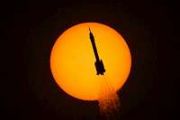
Copernical Team
Earth from Space: Singing dunes and mysterious lakes
 Image:
This Copernicus Sentinel-1 image features part of the Badain Jaran Desert in northwestern China.
Image:
This Copernicus Sentinel-1 image features part of the Badain Jaran Desert in northwestern China. Italian Earth observation fleet gains eight new IRIDE satellites
 Italy's IRIDE Earth observation programme has expanded with the launch of eight Eaglet II satellites, adding a second constellation to the growing national fleet. The spacecraft rode into orbit on a Falcon 9 mission that lifted off from Vandenberg Space Force Base in California at 19:44 CET on 28 November, with deployment completed about an hour after launch and signals from all satellites later
Italy's IRIDE Earth observation programme has expanded with the launch of eight Eaglet II satellites, adding a second constellation to the growing national fleet. The spacecraft rode into orbit on a Falcon 9 mission that lifted off from Vandenberg Space Force Base in California at 19:44 CET on 28 November, with deployment completed about an hour after launch and signals from all satellites later Greece deploys first national ICEYE radar satellites for disaster monitoring
 Two new ICEYE radar satellites have entered service under Greece's National Small Satellite Programme, expanding the country's capacity to track floods, wildfires, landslides and other hazards as well as areas of security interest on land and at sea.
The pair of synthetic aperture radar spacecraft were launched on 28 November 2025 on SpaceX's Transporter-15 rideshare mission from Vandenber
Two new ICEYE radar satellites have entered service under Greece's National Small Satellite Programme, expanding the country's capacity to track floods, wildfires, landslides and other hazards as well as areas of security interest on land and at sea.
The pair of synthetic aperture radar spacecraft were launched on 28 November 2025 on SpaceX's Transporter-15 rideshare mission from Vandenber Gels may have given early Earth chemistry a place to organize into life
 An international team from Japan, Malaysia, the UK, and Germany has proposed that life on Earth may have emerged within sticky, surface-bound gels that formed before the first cells. The researchers argue that these prebiotic gels, attached to mineral or other surfaces, could have provided both structure and chemical environments that helped early chemistry progress toward biology.
The tea
An international team from Japan, Malaysia, the UK, and Germany has proposed that life on Earth may have emerged within sticky, surface-bound gels that formed before the first cells. The researchers argue that these prebiotic gels, attached to mineral or other surfaces, could have provided both structure and chemical environments that helped early chemistry progress toward biology.
The tea Small satellite mission targets maritime activity monitoring from orbit
UK plasma thruster test positions Pulsar Fusion for larger satellite propulsion
 Pulsar Fusion and partners have tested what they describe as the largest space plasma engine yet fired in Britain, designed to provide high-thrust in-space propulsion for heavier satellites. The engine, which the company reports is roughly ten times larger than its previous plasma thrusters, was demonstrated at the University of Southampton on 29 January in a large vacuum chamber to replicate on
Pulsar Fusion and partners have tested what they describe as the largest space plasma engine yet fired in Britain, designed to provide high-thrust in-space propulsion for heavier satellites. The engine, which the company reports is roughly ten times larger than its previous plasma thrusters, was demonstrated at the University of Southampton on 29 January in a large vacuum chamber to replicate on NASA extends ISS National Lab management contract through 2030
 The Center for Advancement of Science in Space will continue to manage the International Space Station National Laboratory for at least another five years, CASIS announced on Thursday.
CASIS has managed the ISS National Lab since 2011, after Congress created it to enable researchers to build a "robust market" in low Earth orbit by leveraging the unique environment that exists in space, CAS
The Center for Advancement of Science in Space will continue to manage the International Space Station National Laboratory for at least another five years, CASIS announced on Thursday.
CASIS has managed the ISS National Lab since 2011, after Congress created it to enable researchers to build a "robust market" in low Earth orbit by leveraging the unique environment that exists in space, CAS Congress warned that the U.S. faces a new space race with China
 The United States has entered a consequential new era of competition with China in space - one that lawmakers said will shape global power, economic security and military advantage for generations.
House Science, Space and Technology Space and Aeronautics Subcommittee Chairman Mike Haridopolos, R-Fla., posed the issue during a hearing Thursday as a question for the future.
"Will huma
The United States has entered a consequential new era of competition with China in space - one that lawmakers said will shape global power, economic security and military advantage for generations.
House Science, Space and Technology Space and Aeronautics Subcommittee Chairman Mike Haridopolos, R-Fla., posed the issue during a hearing Thursday as a question for the future.
"Will huma Space debris: Will it take a catastrophe for nations to take the issue seriously?
Verifying that you are not a bot
Satellite surge threatens space telescopes, astronomers warn
 Light from the half a million satellites that humanity is planning to launch into Earth's orbit in the coming years could contaminate almost all the images taken by space telescopes, NASA astronomers warned Wednesday.
Scientists have already been sounding the alarm about how light pollution from increasingly massive satellites threaten the future of dark skies seen from the ground.
Now,
Light from the half a million satellites that humanity is planning to launch into Earth's orbit in the coming years could contaminate almost all the images taken by space telescopes, NASA astronomers warned Wednesday.
Scientists have already been sounding the alarm about how light pollution from increasingly massive satellites threaten the future of dark skies seen from the ground.
Now, 






























